Read Reviews
The Best 2-Burner Gas BBQs
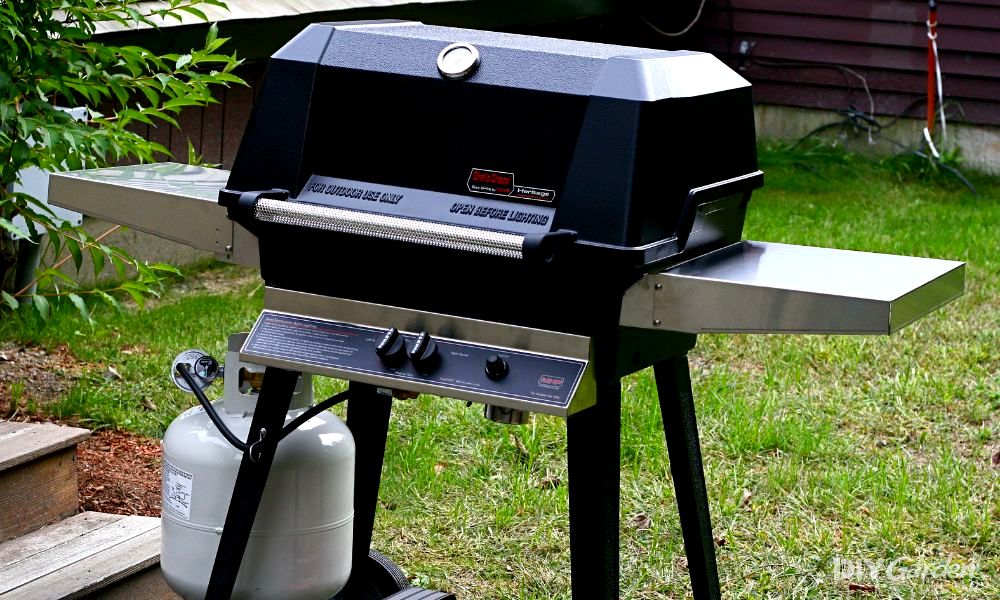
-
Best overall - Charles Bentley Deluxe Auto Ignition 2 Burner Gas BBQ
-
Best premium design - Fire Mountain Everest 2 Burner Gas Barbecue
-
Best for versatility - Char-Broil Advantage Series 225S - 2 Burner Gas Barbecue
-
Best for parties - Char-Broil Convective Series 210B - 2 Burner Gas Barbecue
-
Best value for money - Dellonda 2 Burner Gas BBQ Grill
2-Burner Gas BBQ Reviews
1. Charles Bentley Deluxe Auto Ignition 2 Burner Gas BBQ
Best overall
- Easy to assemble in around an hour
- Enough space to cook for four to six people
- Comes with a propane regulator and hose included so there’s no need to purchase one separately
- Full width aluminium drip tray means cleaning is very easy
- Two wheels and lightweight construction means it’s easy to move in and out of storage
- Warming grill gets very hot when BBQ is used and may continue cooking food as opposed to just keeping it warm
- Two side shelves are fixed and cannot be folded downwards to make the BBQ more compact
- Cooking Area
- 45x45cm
- Warming Rack?
- Yes
- Dimensions
- 58.5x96.5x101cm
- Weight
- 12.7kg
- Design
- 5
- Features
- 5
- Assembly Ease
- 5
- Value for Money
- 5
The Charles Bentley Deluxe Auto Ignition 2 Burner Gas BBQ is a powerful yet compact two-burner gas BBQ. Thanks to its design, it’s the best gas barbecue overall.
Suitable for fitting in smaller areas, this gas BBQ has a very manageable 58.5 x 96.5 cm footprint. The cooking area is 45 x 45 cm which can accommodate food for around four to six people.
It features two stainless-steel burners, producing a total of 7.2 kW of power. The burners can be lit using the integrated ignition, so there’s no messing around with matches or lighters. As a result, this gas BBQ is simple to light every time. As an added benefit, the BBQ comes with a UK standard regulator and hose included (suitable for propane gas), which a lot of gas barbecues make you buy separately.
The gas canister can be hidden out of sight underneath the BBQ where there is a fabric screen to conceal the compartment. The fabric attaches with Velcro and is very easy to put on and take off.
Above the stainless steel grill cooking area, there’s a warming plate. This is a small, flat sheet of metal with some holes cut into it for ventilation. My advice would be to not leave food on this plate for too long once cooked, as the flat metal sheet can get very hot, occasionally to the point where it may burn food.
There are a few additional features included with this gas BBQ. It has two side tables for food prep and storage, as well as a stainless steel thermometer on the hood of the BBQ so you don’t have to keep opening the lid.
Not only does this gas BBQ have a small footprint, but it’s also very easy to move. It’s fitted with two 15 cm wheels on one side, meaning that the BBQ can simply be tipped and rolled out of storage. Plus, it weighs just 12.7 kg; therefore, if you need to move it up and down steps, it can generally be lifted by one person.
Unlike many of the gas barbecues I’ve reviewed in my time, this particular model is very easy to assemble. It arrives part assembled and takes about an hour to finish putting together thanks to the clear instructions.
Overall, this is the best gas BBQ with two burners overall. It offers a desirable combination of value and features; plus, its small footprint means it’s great for those with limited storage space.
Did you find this review helpful?
2. Fire Mountain Everest 2 Burner Gas Barbecue
Best premium design
- Large enough to cook for up to four people
- Cooking surface divided: half grill, half griddle, giving more flexibility when cooking
- Cast iron grates are easy to remove and clean
- Side table can be used to prepare food or store plates
- Bars at the front for hanging cooking utensils and a hook for oven gloves
- Although straightforward, assembly is a long process and takes two to three hours
- Cooking Area
- 47x42cm
- Warming Rack?
- Yes
- Dimensions
- 56x114x106cm
- Weight
- 28kg
- Design
- 5
- Features
- 5
- Assembly Ease
- 3
- Value for Money
- 4.5
The best gas BBQ if you’re after a premium option with two burners, this sleek and stylish Fire Mountain Everest 2 Burner Gas Barbecue is perfect for enjoying long, sunny afternoons.
This gas barbecue is small but mighty, with a relatively compact footprint of 114 x 56 cm. There is enough space on the cooking grates to cook for three to four people (it has a cooking area of 1947 cm²).
As you would expect for a premium model, it comes equipped with a piezo ignitor which means it lights instantly every time. There’s also a regulator and hose included, compatible with propane gas.
When it comes to cooking, it’s easy to monitor and control the temperature of this gas BBQ. The gas burners are adjustable and there is a thermometer fitted into the lid to keep track of the temperature inside. The hood can be closed for indirect cooking and to increase the heat.
The cooking area is divided in two, half grill and half griddle plate – both made from cast iron. This makes it possible to be a bit more inventive with the types of food you are cooking (if you want!). The cast iron grates also retain heat well. On top of these two cooking areas, there’s also a warming rack to keep food warm whilst cooking other items.
The grill and griddle are easy to remove after use, making them straightforward to clean.
Designed with both portability and easy storage in mind, this gas BBQ has two large wheels which make it easy to tilt and roll around the garden. It’s not the lightest on the market, at 28 kg, but should still be reasonably easy to manoeuvre thanks to the wheels.
Like all the best gas BBQs, this model also has integrated storage. There’s a shelf at the bottom which can be used to conceal the gas bottle, as well as two side shelves which increase the preparation area. On top of this, there are some bars and hooks at the front which can be used for hanging cooking utensils, cloths or oven gloves.
When it comes to assembly, putting this two burner BBQ together is relatively straightforward but time consuming. It takes around two to three hours. There are quite a lot of different parts, but as long as its approached methodically, the instructions are sufficiently clear and helpful.
On account of the design and construction of this gas barbecue, it’s the best gas BBQ if you want a premium 2-burner option. It looks stylish, with its silver and black colour scheme, and offers a lot of different options for preparing and cooking BBQ food. In particular, the cast iron grill and griddle means you have a few more options when it comes to your meals, and it can also be used to roast large cuts of meat.
Did you find this review helpful?
3. Char-Broil Advantage Series 225S - 2 Burner Gas Barbecue[ SAVE 15% ]
Best for versatility
- Grill and griddle plate allow for more diverse cooking options
- Fitted with a TRU Infrared cooking technology which is designed to use less gas
- Heats evenly across the entire cooking surface
- Four wheels means the BBQ doesn’t need to be tipped up to be moved
- Clear instructions help make assembly straightforward (even if it takes a while)
- Electronic ignition requires an AA battery
- Cooking Area
- 44.2x43.5cm
- Warming Rack?
- Yes
- Dimensions
- 43.74x23.62x44.49cm
- Weight
- 43.1kg
- Design
- 4.5
- Features
- 4.5
- Assembly Ease
- 4.5
- Value for Money
- 4.5
For foodies who like to try different cooking styles with their BBQs, the Char-Broil Advantage Series 225S – 2 Burner Gas Barbecue has both a standard grill and a plancha plate which works as the perfect hot griddle station. You can use the grill to cook sausages and burgers in the evening, and the griddle for omelettes, pancakes and bacon when morning rolls round!
The Char-Broil 225S is the best gas BBQ for those who want a variety of cooking options for small groups.
Suitable for both beginner and experienced chefs, this gas BBQ is very easy to use. It features Char-Broil’s ‘TRU infrared’ cooking system which is designed to produce juicer food, reduce flare ups and use less gas – that can’t be a bad thing! It’s also easy to light, equipped with Surefire electronic ignition (which requires two AA batteries).
This gas barbecue has a compact cooking grate with the capacity to cook for 2 – 4 people at once. It’s not the biggest on the market but will still cater well to small gatherings. To help with cooking it has a built-in lid thermometer as well as a warming rack and two side shelves that can be used for food preparation.
With a relatively small footprint of 111 x 60 cm, this BBQ is easy to store in tight areas. It is relatively heavy though, at 43.1 kg. To help move it around, this gas BBQ is fitted with four wheels (instead of the more-commonly-found two wheels) – two of these are locking castor wheels so it can be secured in place. These wheels will be a welcome addition, but the weight may still be difficult for some to manage – particularly if it needs to be moved over uneven terrain or up and down garden steps.
As with many gas barbecues, there’s a fair amount of assembly required. The instructions are quite clear, which definitely helps, but it will still take approximately two hours to put this BBQ together. It comes with a propane regulator and hose included. There is a cupboard, with a door, for storing the gas bottle.
Overall, this is the best gas BBQ if you want a 2-burner model that can cook for small groups using a variety of cooking options. The grill and griddle offer a lot of flexibility and it has the added bonus of being equipped with Char-Broil’s TRU infrared system as well.
Did you find this review helpful?
4. Char-Broil Convective Series 210B - 2 Burner Gas Barbecue[ SAVE 27% ]
Best for parties
- Enough cooking space for approximately 12 burgers
- Excellent heat distribution cooks food very evenly
- Solid, quality feel to overall build
- Comes with two individual cast iron grill plates which are easier to clean than one large plate
- Propane hose and regulator included
- Needs to be lifted by the opposing side shelf as there’s no handle
- Takes around 40 minutes to deep clean after use as some sections are awkward to reach
- Cooking Area
- 41.5x47cm
- Warming Rack?
- Yes
- Dimensions
- 111x62.2x114.3cm
- Weight
- 29kg
- Design
- 4.5
- Features
- 4
- Assembly Ease
- 3.5
- Value for Money
- 4
This Char-Broil Convective Series 210B – 2 Burner Gas Barbecue can cook at least 12 burger patties at once, making it the best gas BBQ for parties. It’s also a smart, modern-looking BBQ with a contemporary black finish, powered by two burners.
With a compact footprint of 111 x 62 cm, this Char-Broil gas BBQ is easy to store in small garden sheds or garages, yet the main grill is still quite large. The cast iron grates retain heat well, providing excellent heat distribution, and can be separated into two parts to make them easy to clean.
There is a built-in lid thermometer on the gas BBQ’s hood which will help cook food to perfection, without constantly having to open the lid – something that definitely helps with relaxed cooking at parties! Of course, the hinged lid can be left either open or closed during the cooking process – open it to sear steaks or burgers, or close it to cook indirectly, for example when slow cooking chicken or fish. Once cooked, your food can be transferred to the wire warming rack, which can also be used to lightly toast burger buns or rolls.
When it comes to preparing food for several people, the side shelves on this Char-Broil gas barbecue will be another welcome feature. The shelves are perfect for keeping food, condiments, marinades and drinks to hand.
It’s easy to wheel the Char-Broil 210B around by simply lifting one side. It’s fitted with two reasonably-sized wheels that should be able to cope with a mixture of terrain. However, at 29 kg it should be noted that this gas barbecue can be a little heavy.
The final thing to take into account is the assembly. It’s not overly complicated, but there are a lot of pieces which can be a little daunting. To put this gas barbecue together, you’re looking at an assembly time of two to three hours. You’ll also need an AAA battery for the electric ignition, but it does come with a propane gas regulator and hose included.
On account of this BBQ’s capacity and design, it’s the best gas barbecue if you want a 2-burner model for entertaining. Although it’s only small, the Char-Broil 210B is still able to cook a decent amount of food which makes it very versatile and perfect for barbecue season!
Did you find this review helpful?
5. Dellonda 2 Burner Gas BBQ Grill
Best value for money
- Comes with a waterproof PVC cover included
- Drip tray can be removed for easy cleaning
- Temperature gauge allows you to monitor the temperature without losing heat
- A good price given the size of the grilling space and extra features
- Piezo ignition means it’s easy to light every time
- The included cover is very lightweight and needs to be secured
- Assembling the legs can be difficult if the holes don’t line up
- Stainless steel edges can be very sharp so care is needed
- Cooking Area
- 48x42cm
- Warming Rack?
- Yes
- Dimensions
- 110x57x98cm
- Weight
- 24kg
- Design
- 5
- Features
- 4.5
- Assembly Ease
- 3
- Value for Money
- 5
The Dellonda 2 Burner Gas BBQ Grill is a quality gas BBQ that comes with a water-resistant PVC cover included. Given that a cover often needs to be bought separately when you buy outdoor equipment, this is the best gas barbecue if you’re after value for money.
Plus, that’s not all there is to love about this 2-burner BBQ, either. To start with, it has a good sized cooking area, made from stainless steel, that can cater for up to six people. The cooking grate measures 48 x 42 cm and then there is a reasonable 48 x 12 cm warming area on top of this.
When it comes to cooking, the two gas burners provide balanced heat distribution across the entire grill surface meaning food cooks evenly. The temperature dials make it possible to quickly alter the cooking temperature, and the thermometer on the lid means you can monitor the interior temperature without opening the lid and losing heat. The BBQ is equipped with piezo ignition, making it easy to start. It also comes with a 27 mm regulator and hose included, which can be used with propane fuel.
Another great thing about this gas BBQ is that it’s easy to clean. The cooking grates are made from high-quality steel with a gloss enamel coating which should help stop food from sticking. There is also a drip bucket that collects oil and grease, stopping it from collecting at the bottom of the BBQ.
This gas barbecue is relatively lightweight, weighing 24 kg. It’s fitted with two wheels on one side that enable it to be lifted and pushed to the right spot in the garden.
In terms of assembly, it generally takes around two hours to put this BBQ together. This is mostly because, as is the case with a lot of gas-powered barbecues, there are a lot of separate pieces included. The instructions themselves are relatively easy to understand, although attaching the legs can require a bit of additional thought. One additional thing to bear in mind is that the included cover is relatively lightweight, therefore it will likely need to be tied or weighted down to properly protect the BBQ.
Nevertheless, thanks to the inclusion of a cover, as well as the all-round reasonable price, this is the best gas BBQ if you want a value-for-money 2-burner model.
Did you find this review helpful?
Compare Product Features
Use the dropdown to sort the table by the feature you want to see.
Charles Bentley Deluxe Auto Ignition 2 Burner Gas BBQ
- 5
- 45x45cm
- Yes
- 58.5x96.5x101cm
- 12.7kg
Fire Mountain Everest 2 Burner Gas Barbecue
- 4.4
- 47x42cm
- Yes
- 56x114x106cm
- 28kg
Char-Broil Advantage Series 225S - 2 Burner Gas Barbecue
- 4.5
- 44.2x43.5cm
- Yes
- 43.74x23.62x44.49cm
- 43.1kg
Char-Broil Convective Series 210B - 2 Burner Gas Barbecue
- 4
- 41.5x47cm
- Yes
- 111x62.2x114.3cm
- 29kg
Dellonda 2 Burner Gas BBQ Grill
- 4.4
- 48x42cm
- Yes
- 110x57x98cm
- 24kg
How to Choose The Best 2-Burner Gas BBQ
There’s not much better than stepping outside to the delicious aroma of food grilling on the BBQ, but traditional Charcoal BBQs require a lot of preparation when it comes to loading the coals and waiting for them to preheat.
This is where a gas BBQ really comes into its own! Perfect for spontaneous weeknight dinners and hassle-free weekends, gas-powered BBQs heat up in just 5 – 10 minutes. Gas barbecues are fast gaining in popularity, and there’s a huge number on the market to choose from.
Designed for small households and families, two-burner barbecues offer all the benefits of a gas BBQ packed into a neat and compact unit. You’ll be able to control each burner individually, allowing you to sear steak at high temperature, while simultaneously cooking vegetables, sausages or chicken at a lower heat.
Below, you’ll find some tips to help you choose between the best gas barbecues with two burners.
Comparing Gas and Charcoal BBQs
There are pros and cons to both gas and charcoal grills, and the topic of which BBQ to go for can be quite divisive! Let’s take a look at the main advantages and disadvantages of charcoal and gas powered BBQs.
Gas Barbecues
Advantages:
- Quick to heat up and easy to use – you can often start cooking in just 5-10 minutes
- Allow you to precisely set the temperature of each burner using the control valves
- Gas barbecuing allows you to cook with direct heat
- Some come with a side burner which means you can heat a pan or saucepan on the side (this feature might be present in a BBQ with three or more burners)
Disadvantages:
- You’ll need to buy, store and dispose of gas canisters
- Gas grills don’t create a smoky flavour like charcoal grills
Charcoal Barbecues
Advantages:
- Versatile and get extremely hot
- Often cheaper to buy than gas-powered BBQs
- Indirect grilling is easier to achieve
- Food takes on a smoky flavour
Disadvantages:
- Harder to control the temperature compared to gas barbecues
- Generally takes at least 30 – 40 minutes to be ready to cook on
- Often difficult to light, particularly in windy conditions
Charcoal or Gas – Which is Better?
So, spontaneous people will love the ease of use of a gas BBQ, as you can have a grill that’s ready to cook on in just 10 minutes. If you prioritise flavour over speed, you may prefer a charcoal BBQ, as food will take on that authentic smoky flavour.
Uses For a 2-Burner Grill
You might be wondering about how many burners you need. There are certainly a lot of sizes of gas BBQ on the market, from two to eight burners.
Generally speaking, the more burners there are, the larger the cooking space. However, the difference in cooking areas between a 2 or 3 burner BBQ may not be as large as you might think. In fact, some 2-burner grills have a cooking grate that’s the same size as on 3-burner grills. The real difference is that a 3-burner gas BBQ could offer a bit more flexibility if it you want a side burner.
Each burner can be set to a different temperature, so more burners will give you more control over the cooking temperature. Many people won’t need more than two burners when cooking for a family or a few friends.
One of the benefits of 2-burner grills is that they’re some of the best gas barbecues for low fuel consumption. For example, a 6 burner gas BBQ will generate more BTUs per hour, costing more in fuel over time. 2-burner BBQs will cost less in fuel, and they are usually reasonably cheap barbecues to purchase outright as well.
They also have a reasonably small footprint.
Selecting the Right Size BBQ
2-burner BBQs are usually suitable for cooking food for two to six people. Most of the time, their cooking grate is between 45 x 45 cm and 50 x 50 cm. For the most part, this is plenty of space for cooking for several people, even if you have to stagger the cooking slightly to accommodate everyone.
The best gas barbecues have a warming rack so you can keep food warm in order to serve it at the same time. A warming shelf is particularly useful to have on a small gas barbecue, for those occasions when you’re entertaining a few more guests (a BBQ side table can also come in handy).
Of course, if you’re someone who frequently holds bigger parties and events in the summer, you’ll benefit from having a larger gas grill. In this instance, you may prefer a gas barbecue with three or more burners, so you can cook a range of foods at the same time.
If you’ve not got a lot of storage space, or you’ve only got a small area in which to place your gas barbecue, the best gas BBQ will be a 2-burner model with a compact footprint. Remember to get a cover for your BBQ to protect it during storage.
If you’ve got a few steps between your storage area and garden, or you’re not going to be able to pull it along using wheels, you should look for a BBQ that you can lift comfortably. Whilst some 2-burner barbecues weigh around 10 kg, others can weigh closer to 30 kg. If you want an even smaller unit, you could consider a portable BBQ.
BBQs may have two or four wheels. Four isn’t strictly necessary, but they do allow the gas barbecue to stay level when it’s being moved around. This could be helpful if there is a sudden rainstorm or if smoke starts blowing over guests due to a change in wind direction.
The best gas BBQ for wheeling over hard, level surfaces will have castor wheels with brakes. If you’re going to be taking your gas barbecue across your lawn or other tougher terrain, opt for larger wheels.
Check out our main BBQ page to read various BBQ reviews and articles on BBQing.
Which Type of Gas to Use
When it comes to gas grills, you usually have two fuel choices – butane or propane.
Butane comes in blue cylinders, and propane comes in red.
Propane is a popular choice for those living in colder climates as it continues to burn well in cold temperatures, down to -42°C. This is a great choice for those who like to BBQ year round (yes, including in the winter!).
Butane burns well in temperatures down to -2°C which makes it less suitable for use in colder weather. For most of us, BBQing during the summer in the UK, this won’t make a difference. It’s generally a little bit cheaper than propane and doesn’t burn as fast. This means you’ll need to purchase it less frequently, potentially saving you a little more money in the long run.
Gas Regulators
Some of the best gas barbecues come with a regulator and hose included, whilst others will require a regulator to be purchased separately.
Regulators control the flow of gas to the BBQ, preventing too much from being used at any one time.
You’ll need a different type of regulator depending on whether you’re using propane or butane gas. If your gas barbecue comes with a gas regulator included, you may still need to buy one separately if it’s not compatible with the type of gas you want to use.
Another thing to check is whether the regulator is a screw-on or clip-on regulator. This is another factor that alters the type of gas canister that the regulator is compatible with.
READ NEXT: The Best BBQ Smokers
2-Burner Gas BBQ FAQs
After every use you should clean the grills. Some BBQs have grills that can fit into the dishwasher (check with the manufacturer that they are suitable for washing in the dishwasher), other grills may need to be washed in the sink.
Every three months (during BBQ season) you should aim to clean the entire interior of your gas BBQ. Clean the exterior once a month.
To clean your gas BBQ, you should first disconnect the gas tank. Then use a grate cleaner and grill brushes to clean the grills, interior and vaporiser bars. Remove any grease after leaving the grate cleaner to settle for 30 – 60 seconds.
Don’t reassemble the gas barbecue until each part has dried thoroughly.
A dual fuel BBQ allows you to cook with both gas and charcoal; it’s the best gas barbecue option if you want the flexibility of both worlds. For example, if you’ve got all day to prep, you can use the charcoal function to produce that delicious smoky flavour. If you’re short of time, using the gas barbecue option will allow for more spontaneity.
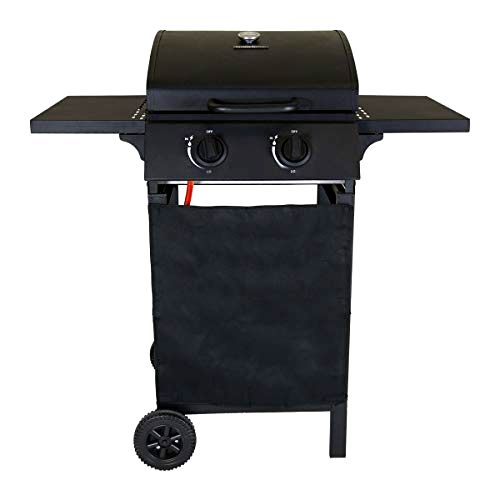
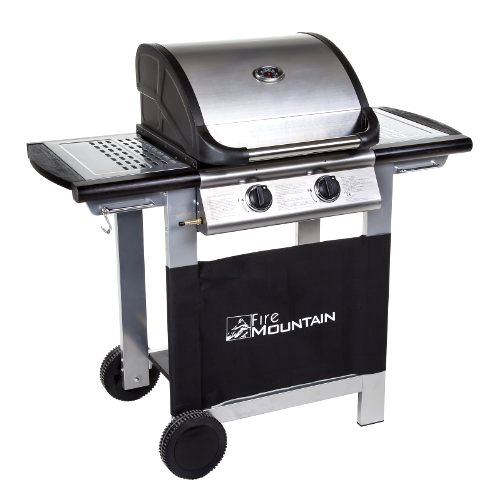
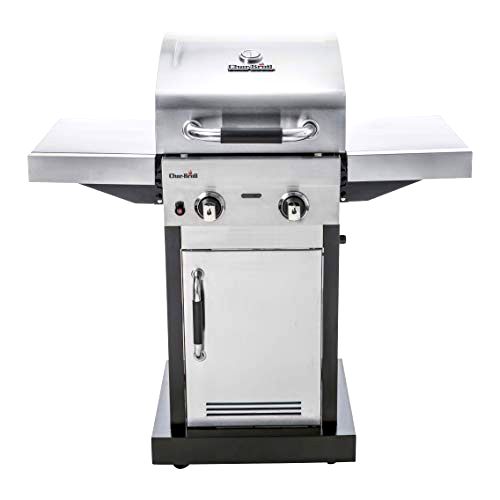
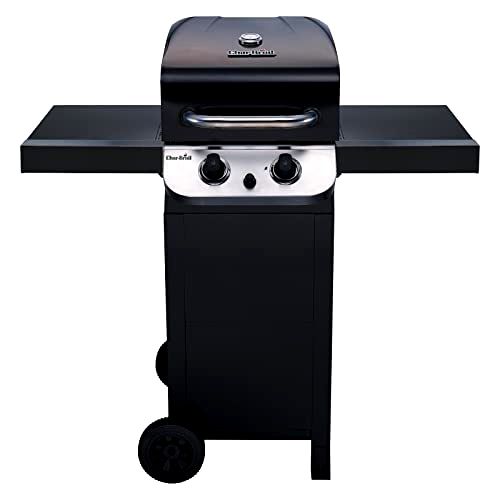
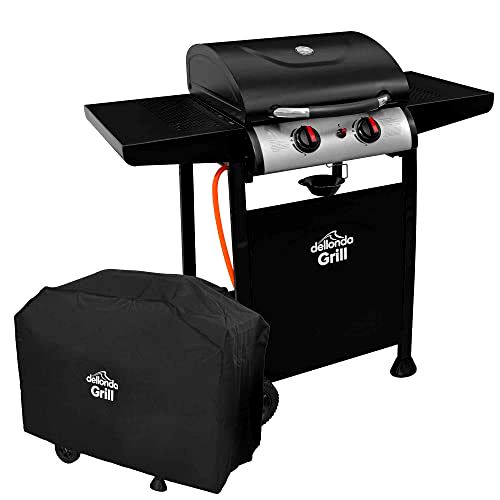

Share